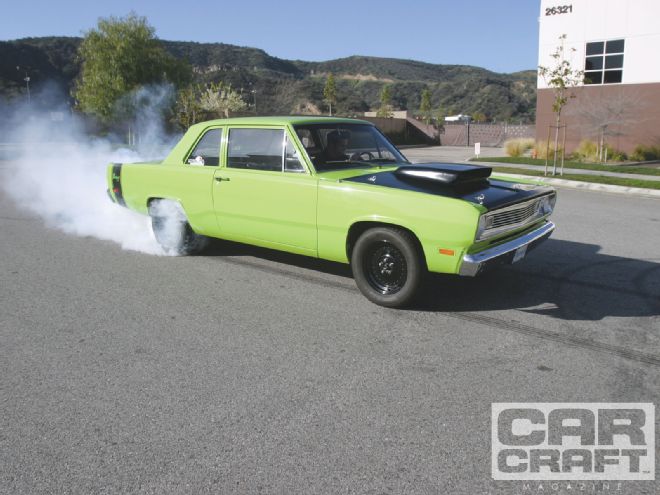
Shannon Hudson's performance world is evolving. For years, he drove a lime-green '69 Valiant with the total drag racing package, right down to the Mickey Thompson ET Drag Radials and 4.11 gears. Outside the dragstrip, the car wasn't as much fun, especially on Los Angeles freeways where he'd have to spin his small-block to 3,600 rpm just to keep from getting run over. Because Hudson, the owner of Redline Gauge Works, is a car crafter whose taste had changed, the time had come to do something different. He decided to ditch the drag race package, put fat tires on all four corners, improve the A-Body's handling, and swap out those 4.11s for something more streetable. The first step was to perform the gear change, so he pulled his Valiant up on the rack at his buddy Dave Reeves' rearend shop, and we stopped by to document the conversion to a set of 3.55:1s. Here's how it all went down.
Rear Axle Assembly - The Buildup
The Mopar 8 3/4-inch rear axle assembly was Chrysler's midsize gear carrier system-smaller than the massive Dana 60 used in the Hemicars yet beefier than the pedestrian 8 1/4-inch. But not all 8 3/4-inch rears are the same, as there are three different casting numbers (found on the side of the case) based on pinion bearing size. This is important because parts, torque values, and even the pinion preload specs vary based on these case dimensions. Hudson's 489 centersection originated in a '70 Challenger using the largest bearings of the three casting numbers of 41, 42, and 89. Hudson had already contacted Randy's Ring & Pinion and ordered a set of 3.55:1 gears, a master rebuild kit, and stronger axles with a larger 5x4 1/2-inch wheel mounting bolt pattern for a set of Rocket wheels.
By the time we got to Reeves' shop, technician Dale Lee had already popped the axles and the 8 3/4-inch rear axle assembly centersection out of the housing, stripped the centersection, and had it sitting on the bench ready for assembly. One thing Lee did before we got there was mark both main caps with a center punch because they do not interchange. Lee also removed the bearing pressed on the pinion shaft to measure the shim thickness. The 4.11 gear had a 0.012-inch shim under the pinion along with 0.036 inch of shims underneath the pinion bearing race closest to the ring gear in the case. Reeves noted that it is common to find shims in both places.
Rear Axle Assembly - Pinion Gear Size Differences Reeves decided to use a 0.015-inch shim under the pinion to compensate for the change in size of the pinion gear. Deep gears like 4.11s employ a small pinion gear, while the 3.55's pinion is quite a bit larger. This changes the relationship of the pinion to the ring gear, necessitating a thicker pinion shim to move the pinion gear deeper-or closer to the ring gear centerline. Reeves chose to do it this way based on his experience, and we decided to pass that knowledge along with a chart of pinion shim thickness recommendations that should position the pinion close enough that you shouldn't have to measure pinion depth. Because of this, we did not run through the pinion depth procedure here, but you can find it at CarCraft.com.
PINION SHIM VS. RATIO CHART GEAR RATIO SHIM THICKNESS 3.23 0.015 3.55 0.015 3.73 0.014 3.90 0.013 4.11 0.012 4.30 0.011 4.56 0.010
MOPAR 8 3/4-INCH SETUP SPECS COMPONENT SPEC Ring gear bolts 55 ft-lb Main cap bolts 90 ft-lb Pinion preload (89) new bearing 14-19 in-lb Pinion preload (89) used bearing 6-9 in-lb Total preload (89) new bearing 30-35 in-lb* Ring gear backlash 0.006 to 0.010 inch *Total preload is a combination of turning the pinion and the ring gear without the axles installed.
PARTS LIST DESCRIPTION PN SOURCE PRICE Ford gear additive XL-3 eBay $5.98 Speedi-Sleeve 99187 NAPA 41.49 Yukon 3.55 gearset 24010 Randy's Ring 294.86 Yukon Master Overhaul set 14008 Randy's Ring 131.04 Yukon axle set, 5 x 4.50 21041 Randy's Ring 321.62 Yukon spanner wrench 56027 Randy's Ring 54.77 Yukon bearing race driver HM803110 Randy' Ring 146.10
We've heard the centersection called all kinds of colorful names, such as pumpkin, hog's head, dropout, and pig.
New Gear Break-In
Once those new gears are installed in the rearend, you must curb your enthusiasm for at least a few hundred miles before you begin flogging those burnouts and dragstrip passes. Randy's Ring & Pinion suggests taking it easy on the new gears, especially for the first 15 to 20 miles, with no hard acceleration, then let the gears cool completely. After that, avoid abuse for the first 100 miles and then change the gear lube after the first 500 miles to get rid of the metal that will inevitably be found in the oil from the new gears and bearings.